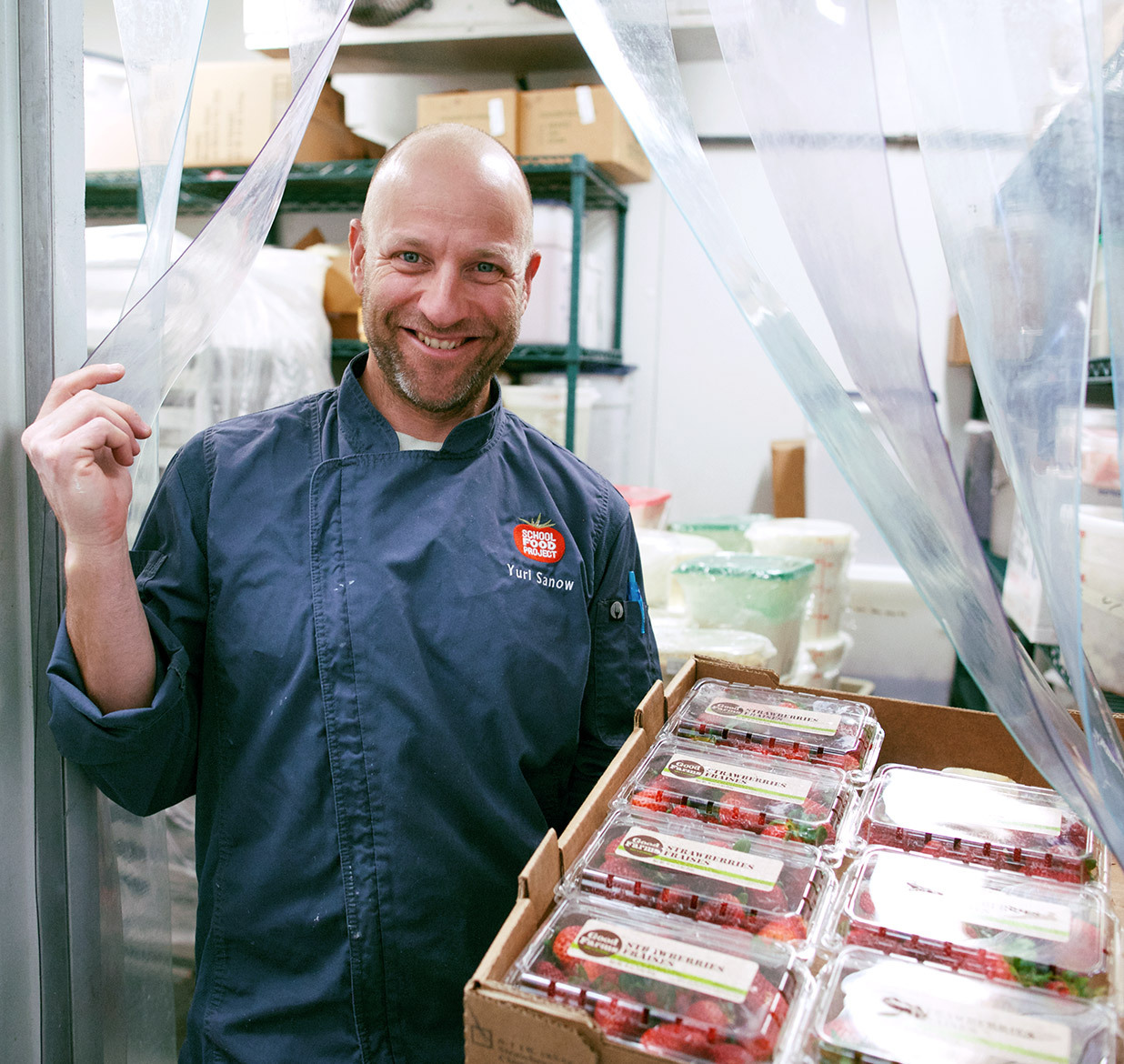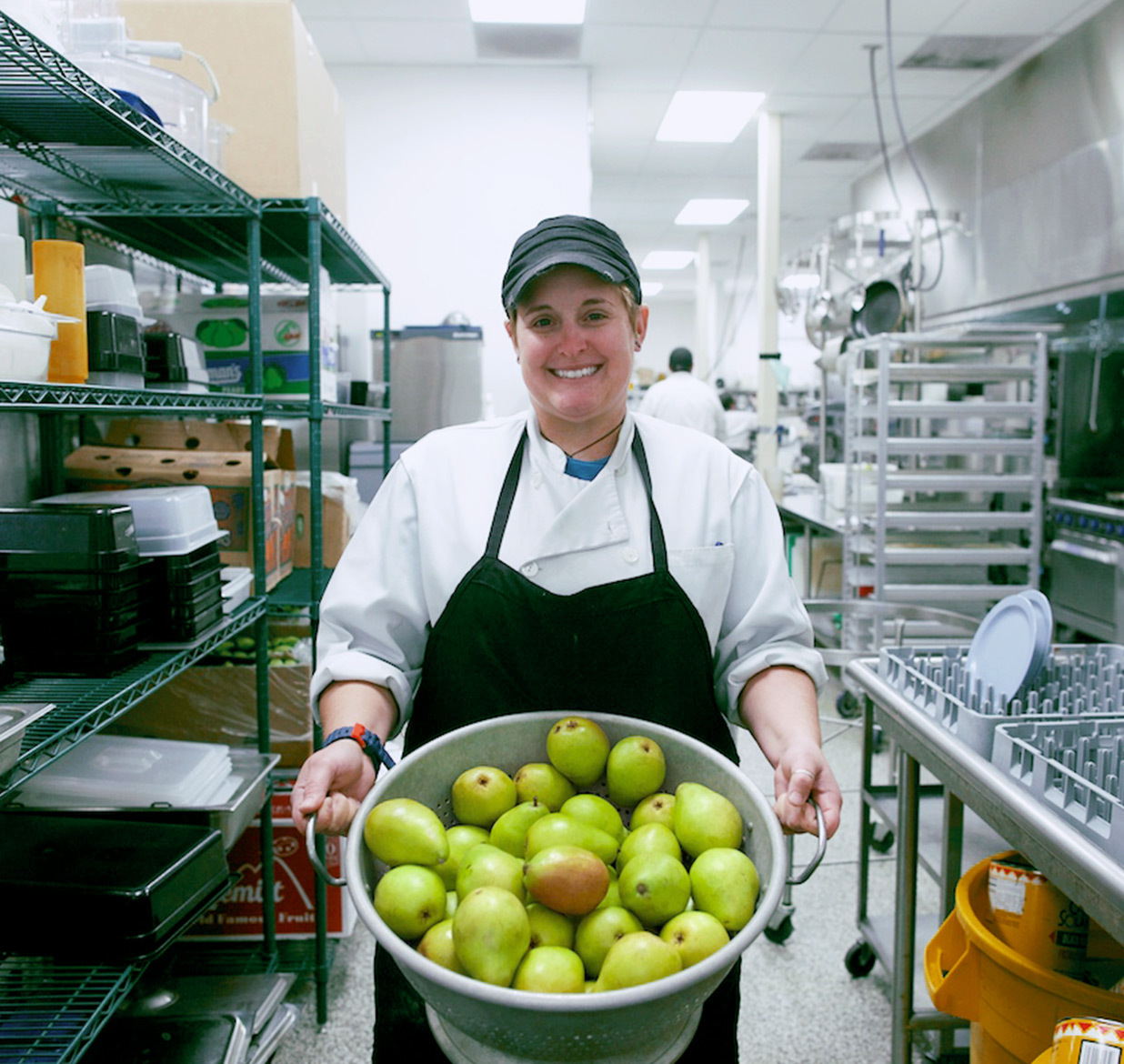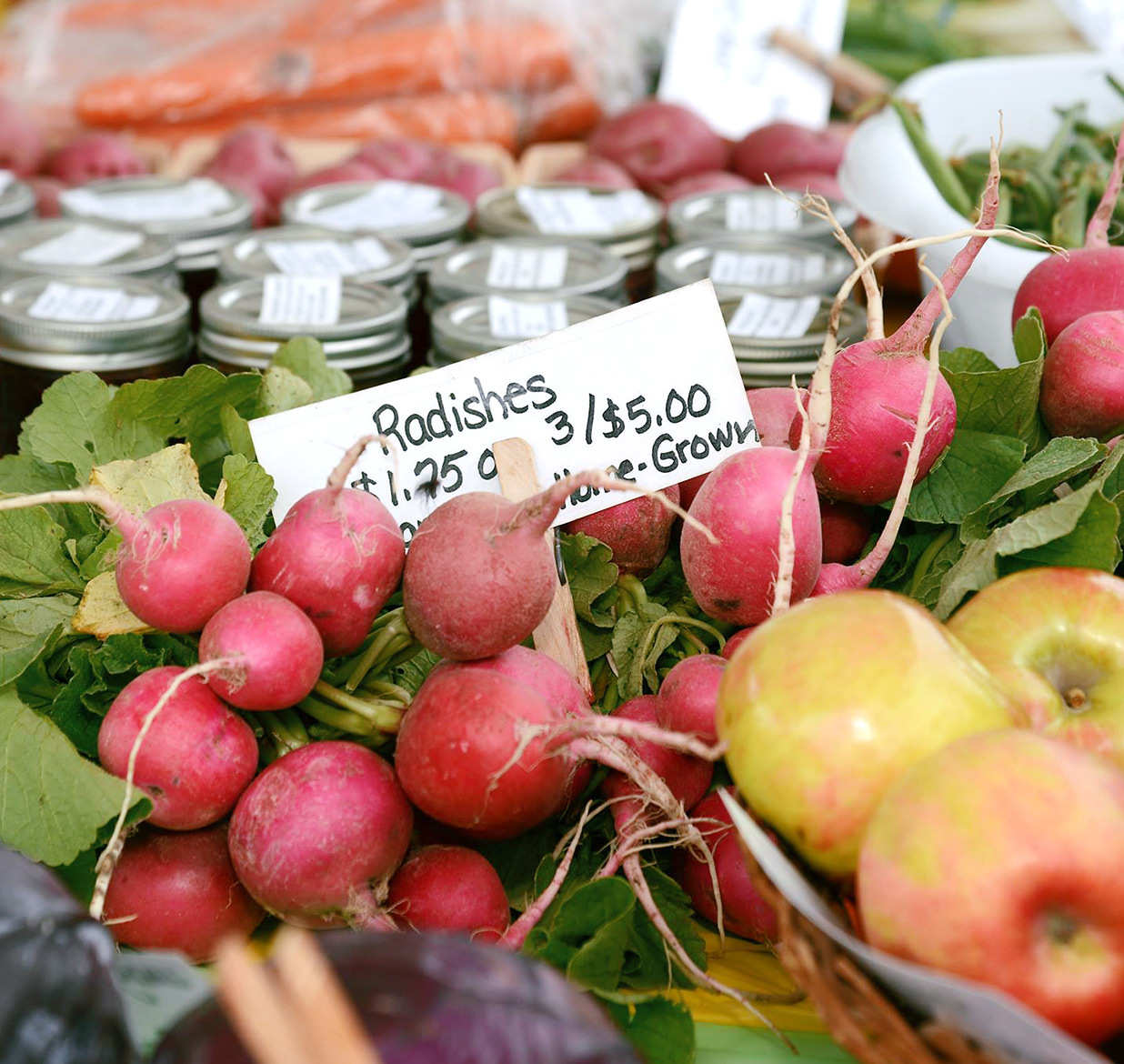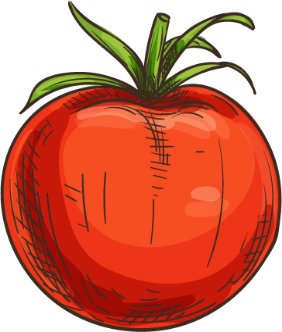
Fresh Food Systems
Establishing relationships with suppliers that support your program vision and goals is critical. Be an informed buyer. Know your history, menus, specifications, and volumes needed.
Conduct research to understand pricing indexes and talk to your colleagues about their vendor experiences. Districts that use Food Standards and define specific vendor requirements (mainly for solicitations and RFPs) will often receive better pricing and services, which is a great asset for a district transitioning to a fresh food system.

Fresh Food Systems
Establishing relationships with suppliers that support your program vision and goals is critical. Be an informed buyer. Know your history, menus, specifications, and volumes needed.
Conduct research to understand pricing indexes and talk to your colleagues about their vendor experiences. Districts that use Food Standards and define specific vendor requirements (mainly for solicitations and RFPs) will often receive better pricing and services, which is a great asset for a district transitioning to a fresh food system.
The federal government requires school district procurement practices to be fair, open, and competitive. For a detailed discussion of the school food procurement regulations and processes, we recommend the Institute of Child Nutrition’s resource manual, Procurement in the 21st Century. For school districts expanding procurement to include purchasing local and regional foods, the USDA Food and Nutrition Service has established the Community Food Systems division, which provides many resources. Up-to-date regulation guidance, webinar trainings, and the excellent resource Procuring Local Foods for Child Nutrition Programs be found on the USDA’s Procuring Local Foods page. This site also offers a step-by-step guide to including local and regional procurement in your plan. For additional resources, visit the Sustainable Procurement section of The Lunch Box.
USDA Foods
For districts that want to shift to a fresh food system, the common question from directors is, “what about my commodities?” The value of USDA Foods to your bottom line cannot be understated. Yes, you will still use your allocation, but like everything else in a Fresh Food System, your allocations should reflect your program vision, food standards, and your goals for menus and procurement. This is not a “one-time and done;” the pace and capacity for change varies district to district.
Terms and Definitions
Pass-through commodities (aka Direct Diversion)
Bulk goods that are diverted and passed through to manufacturers (aka “processors”) for further processing. From there, the processors either ship directly to school districts or the products are delivered to the districts through distributors.
Brown Box (aka Direct Delivery)
Goods that are shipped in standardized finished case packs directly via the USDA.
We acknowledge that the USDA would prefer to refer to both as “USDA Foods,” but “pass-through” and “brown box” are both widely recognized and help differentiate between the two methods.


Terms and Definitions
Pass-through commodities (aka Direct Diversion)
Bulk goods that are diverted and passed through to manufacturers (aka “processors”) for further processing. From there, the processors either ship directly to school districts or the products are delivered to the districts through distributors.
Brown Box (aka Direct Delivery)
Goods that are shipped in standardized finished case packs directly via the USDA.
We acknowledge that the USDA would prefer to refer to both as “USDA Foods,” but “pass-through” and “brown box” are both widely recognized and help differentiate between the two methods.
Resources & Approach
The most widely used handbook for school districts regarding the overall understanding and handling of USDA Foods is the American Commodity Distribution Association’s School Recipient Agency Processing Handbook (ACDA RA Handbook). This regularly-updated guide provides one of the clearest and most detailed explanations for the distribution of USDA Foods to schools.
Though commodities make up only 15-20% of plate costs, school districts can spend significant time and energy managing commodity allocations. Individual states and the USDA Food and Nutrition Service offer information and assistance to help school districts spend the allocation. But truly understanding the complex environment of USDA Foods remains a challenge for even the most seasoned procurement professional. Planning menus annually and early is essential.
Some districts shift their commodity allocation away from ready-to-heat foods by increasing their allocation to the Department of Defense (DoD) Fresh Fruit and Vegetable Program, thus increasing their allocation of ingredients rather than “products.” Another first step might be to reduce the frequency and reliance on popular items. For example, replace pre-made frozen pizza with sauce made with commodity tomato products, commodity cheese, and a purchased frozen crust. By setting specific goals to transition away from processed foods, districts can make headway toward scratch cooking.
Types of Distribution
The two primary types of commodity food distribution as described by the ACDA RA Handbook:
Direct Delivery (also known as Brown Box)
Products, which USDA purchases for delivery to Recipient Agencies, Direct delivery items include both unprocessed and minimally processed products as well as further processed “value added” items. Unprocessed or minimally processed items include canned or frozen fruits and vegetables, raw ground beef, cut up chicken and whole-body turkey, roasted pieces, and sliced cheese. Value added products include items like turkey taco meat, roasted chicken pieces, and frozen fruit cups. These products are not diverted to processors for further processing.
Direct Diversion
Items purchased in bulk form for shipment to further processors on behalf of RAs. Diverted items include chilled chickens and turkey, coarse ground beef and pork and similar items that are used in making finished end products for RAs.

Pass-Through Commodities
Pass-through commodities have an enormous impact on the school food system. For most districts that rely on pass-through, ready-to-heat products, moving away from that model will impact every area of their operation from food delivery to storage to labor.
Approximately 50% of all commodity allocation is diverted to manufacturers for further processing. Almost any brand name, ready-to-heat item that you can think of is available via pass-through. In addition to items like chicken patties, pizza, or packaged burritos, there are also products that compete with some of the brown box commodities like sliced American cheese, fruit cups, chicken fajita meat, and cooked diced chicken. So why would a district divert commodities to receive a pass-through version of cooked diced chicken? This is usually due to convenience and sometimes specification.
Aside from the convenience of heating up a ready-to-serve menu item, the ease of distribution is key to the popularity of pass-through. The states and USDA have worked to improve the distribution methods and delivery schedules for brown box commodities, but it is often less than ideal, particularly for smaller districts. In many states, school districts buy from cooperatives that manage the delivery of both brown box and pass-through, since most districts allocate a combination of the two depending on value and their menu-cycle. For larger districts that have more storage, processors can ship the end product to the district directly (aka “drop-ship”). Drop shipping is the most cost-effective way to deliver a pass-through product to a district.
The popularity of pass-through is understandable since it provides the following:
- Predictable supply and delivery methods (two of the key drivers in procurement)
- Ready-to-heat foods with CN labeling make it easy for school food employees to plan a menu
- The use of the foods promotes the concept of using the commodity allocation to the fullest since the food items can typically be processed into a number of end products. For example, whole chickens diverted to a processor could become chicken nuggets/patties, chicken strips, orange chicken and breaded drumsticks.
Another attraction to pass-through is that the manufactured products are also available commercially. This allows the district to keep a product on their menu cycle once their commodity allocation has been exhausted. For example, a district may distribute bulk chicken to Tyson to make spicy chicken patties, and they can still buy the same product once their bulk chicken allotment is gone. While this eliminates the need to change the menu, it also furthers the manufacturers’ foothold on the school food market.

Whole Food Procurement
Use your vision and procurement goals as a guide when selecting appropriate commodities to use with your entitlement dollars. If eliminating highly-processed foods is a priority, then the menu plan needs to include items that are sustainable for your program from a production standpoint.

Whole Food Procurement
Use your vision and procurement goals as a guide when selecting appropriate commodities to use with your entitlement dollars. If eliminating highly-processed foods is a priority, then the menu plan needs to include items that are sustainable for your program from a production standpoint.
Take advantage of our Recipes section to consider some options, and consider testing ideas with your students. The most common selection of commodity ingredients in scratch programs are those without added ingredients like textured soy protein or other fillers. Whole muscle, raw or cooked protein ingredients like turkey roasts, eight-cut chicken, diced chicken, ground beef, and bulk cheeses are common choices.
Sourcing Strategies: Commercial vs. USDA Foods
The reason that we don’t build menus around sources—meaning USDA Foods or pass-through commodity products vs. commercial products—is because your menu needs to reflect your program vision. That vision may be a multi-year process that requires additional professional development, or renovating/building kitchens or other physical infrastructure to create capacity for growth. In that sense, procurement is ever evolving.
DoD Fresh
Using commodity allocation for DoD Fresh (Department of Defense Fresh Fruit and Vegetable Program) is a popular option for districts who want to focus on “fresh.” This program enables school districts to use their entitlement dollars to buy fresh produce.
The program is operated by the Defense Logistics Agency at the Department of Defense and is available in 46 states, the District of Columbia, Puerto Rico, the Virgin Islands, and Guam. In some states, there is no restriction to allocation amounts, while others limit the percentage. Regional distribution is established through a competitive process and the contracts are awarded periodically.
For districts that are more rural and without access to a regular produce vendor, the DoD program is a huge asset. Districts place by-school orders in the web-based Fresh Fruit and Vegetable Order/Receipt System (FFAVORS). All produce is from the United States and the DoD uses regional suppliers where possible. For DoD, local is defined in three ways: the product is produced within 400 miles; the product is from within the state; or the product is from the area of service.
For districts located in metropolitan markets with multiple produce distribution companies, DoD may serve as a part of the procurement model but not the primary choice due to the inability to develop specific vendor relationships tailored to the district vision.
The other factor to consider is record keeping. While the centralized ordering system is easy to use, it is a by-school order and does not allow for consolidation like the more advanced capabilities of K-12 back-office software. For districts that have product delivered to one central location, this is less of an issue, but for districts that require by-school delivery, there is no current function to export a consolidated district report. In larger districts with by-site delivery, some districts cobble together several ordering and receiving steps that are somewhat outside of their typical ordering standard in order to fit FFAVORS into their routine and maintain transparency.
A Pilot Project for More Fresh Food Procurement
As part of the 2014 Farm Bill, the Agricultural Marketing Service and the Food and Nutrition Service initiated a Pilot Project for Procurement of Unprocessed Fruits and Vegetables in eight States (CA, CT, MI, NY, OR, VA, WA, and WI) to provide more purchasing flexibility and options for unprocessed fruits and vegetables, including minimally processed products such as sliced apples, baby carrots, and shredded lettuce. The pilot project allowed participating states to use qualified, multiple suppliers and products and designate a geographic preference, if desired.
The goal of the Pilot Project was to develop additional opportunities for schools to purchase fresh fruits and vegetables with entitlement funding, while using pre-existing commercial distribution channels and school relationships with growers, produce wholesalers, and distributors.


A Pilot Project for More Fresh Food Procurement
As part of the 2014 Farm Bill, the Agricultural Marketing Service and the Food and Nutrition Service initiated a Pilot Project for Procurement of Unprocessed Fruits and Vegetables in eight States (CA, CT, MI, NY, OR, VA, WA, and WI) to provide more purchasing flexibility and options for unprocessed fruits and vegetables, including minimally processed products such as sliced apples, baby carrots, and shredded lettuce. The pilot project allowed participating states to use qualified, multiple suppliers and products and designate a geographic preference, if desired.
The goal of the Pilot Project was to develop additional opportunities for schools to purchase fresh fruits and vegetables with entitlement funding, while using pre-existing commercial distribution channels and school relationships with growers, produce wholesalers, and distributors.
The focus for districts we’ve engaged with using the program is the ability to use commodity allocation for locally grown foods, however, the process for the growers to become certified is detailed and beyond the abilities of the average small farmer. In addition, distribution can still be challenging, but this is a baby step for the USDA to offer this program and we hope that it will be expanded. The USDA published a final report and infographics outlining the successes of the pilot program.
Cooperative Purchasing
Purchasing Co-ops and Food Buying Groups
Cooperative purchasing groups are a common procurement mechanism in school food, particularly for procurement of pass-through commodities. Co-ops create efficiencies by joining school districts together to produce buying power through volume, reduce costs, and increase product quality and services. Smaller districts that are commonly burdened by lack of scale often benefit from a cooperative buying situation, but it is important to shape the process to meet your district’s specific needs. Detailed explanations of joining or creating a cooperative purchasing group (as well as the pros and cons) are covered in depth in INC’s Procurement in the 21st Century resource manual.
Less typical, but gaining momentum, are buying cooperatives that are specifically created to procure local food. They follow the same principles of a regular school co-op except they focus on Farm to School procurement. The procurement process requires the same rigor of evaluation to determine the appropriate procurement method: informal, Invitation for Bid (IFB), or Request for Proposal (RFP), but the primary goal is to aggregate volume needs of multiple school districts to drive the market forces and obtain the most competitive pricing.
Two legislation changes have made it easier for school food programs to work with local growers. The most recent statutory changes to the 2017 National Defense Authorization Acts (NDAA) increased the federal micro-purchasing threshold from $3,500 to $10,000. The federal simplified acquisitions threshold was also increased from $150,000 to $250,000. Though state or local rules may be more restrictive than Federal rules, these changes have positively impacted some district procurement activities. The higher thresholds make it easier for districts committed to regional procurement to invest more funds locally.
Recommended Next Topic: Informal & Formal Procurement
Procurement is used to obtain goods or services through a multi-step process. Funded mostly by Federal entitlement dollars, school food operators must adhere to strict procurement standards set forth by the Code of Federal Regulations and further defined by USDA, state, and local regulatory guidance.
Recommended Next Topic: Informal & Formal Procurement
Procurement is used to obtain goods or services through a multi-step process. Funded mostly by Federal entitlement dollars, school food operators must adhere to strict procurement standards set forth by the Code of Federal Regulations and further defined by USDA, state, and local regulatory guidance.






